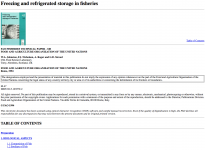Appropriate Technology
In the context of food loss and waste (FLW) reduction, technology is the application of scientific knowledge to minimize loss and waste and produce and market desired fish products. For example, technology such as ice and the cold chain can be used to prevent and retard bacterial and enzymatic spoilage, which is a key cause of FLW in developing countries.
Examples of appropriate technology which can help reduce FLW are:
- Production: improved and more selective fishing gear, and, in aquaculture, equipment to improve water quality and prevent disease
- Post-harvest: raised drying racks, ice machines, insulated boxes, freezers, refrigerated vehicles, improved fish smoking kilns, mechanical dryers, packaging equipment
- Preservation methods: smoking, salting, freezing, and packaging methods
- Use of mobile phones to undertake transactions, make distribution and marketing more efficient
- Equipment to make use of underutilized species or rest raw materials (e.g. surimi production)
- Use of flesh bone separation technology to remove fish meat from by-products such as fish frames
Value chain actors will invest in and adopt appropriate technologies and better practices if they know the investment will be profitable; if they have the right education, information and motivation; are able to invest; and if government policies are supportive, set clear goals and rules of the law that are efficiently enforced. Adoption can be influenced by research and development, dissemination, access to information by end users, availability of financial resources, and pressures from consumers, non-government organizations, the media and the public in general.
Nevertheless, technology on its own is not a guarantee that FLW will be reduced. It has to be maintained in good condition, used properly and fit for purpose, and often requires knowledge and skills for it to be used effectively.
Technology often requires services such as research and development (RnD). This is often led by the private sector, particularly for large scale / industrial fisheries and developed value chains. Whereas technology RnD for small-scale fisheries often requires more support from the public sector, civil society, and academia.
Key Publications
Adoption of Technologies for Sustainable Farming Systems This report provides insight into the Adoption of Technologies for Sustainable Farming Systems workshop. The report includes experiences in developing countries, and encourages use of appropriate technologies for particular farming systems. | |
Technology Options for Feeding 10 Billion People This report presents the potential to leverage new and emerging technologies to feed the future 10 billion world inhabitants and enhancing sustainability in the food processing sector. | |
Freezing and Refrigerated Storage in Fisheries This FAO publication provides an introduction to the operations and equipment used in fish freezing and cold storage on shore and sea, and gives information on applying low temperatures to reduce deterioration of quality. |




